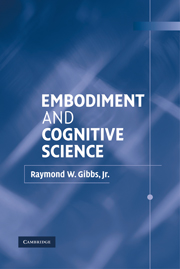5 - Imagery, Memory, and Reasoning
Published online by Cambridge University Press: 05 June 2012
Summary
The history of science reveals many notable examples of the power of embodied thought in creativity and imagination. Scientists frequently acknowledge that their great discoveries are brought about not through formal, purely analytic reasoning, but by “gut feelings” that take shape in the form of rich sensory images and bodily sensations. Albert Einstein, who always recognized his weakness in mathematics, described his creative process in the following way:
The words of the language, as they are written or spoken, do not seem to play any role in my mechanisms of thought. The psychical entities which seem to serve as the elements in thought are certain signs and more or less clear images which can be voluntarily reproduced and combined. … The above mental entities are, in my case, of visual and some of muscular type.
(Hadamard, 1945: 142–3)Einstein's embodied thought processes took particular shape in one of his famous thought experiments where he pretended to be a photon moving at the speed of light. He first imagined what he saw and how he felt, and then became a second photon and imagined what he now experienced of the first photon.
Many scientists, like Einstein, have conceded that formal mathematics was useful for communicating their scientific discoveries, but that the locus of their original ideas was rooted in embodied possibilities. Another scientist, Cyril Stanley Smith, purposefully studied graphic arts to better develop his sense of the structure of metals.
- Type
- Chapter
- Information
- Embodiment and Cognitive Science , pp. 123 - 157Publisher: Cambridge University PressPrint publication year: 2005



